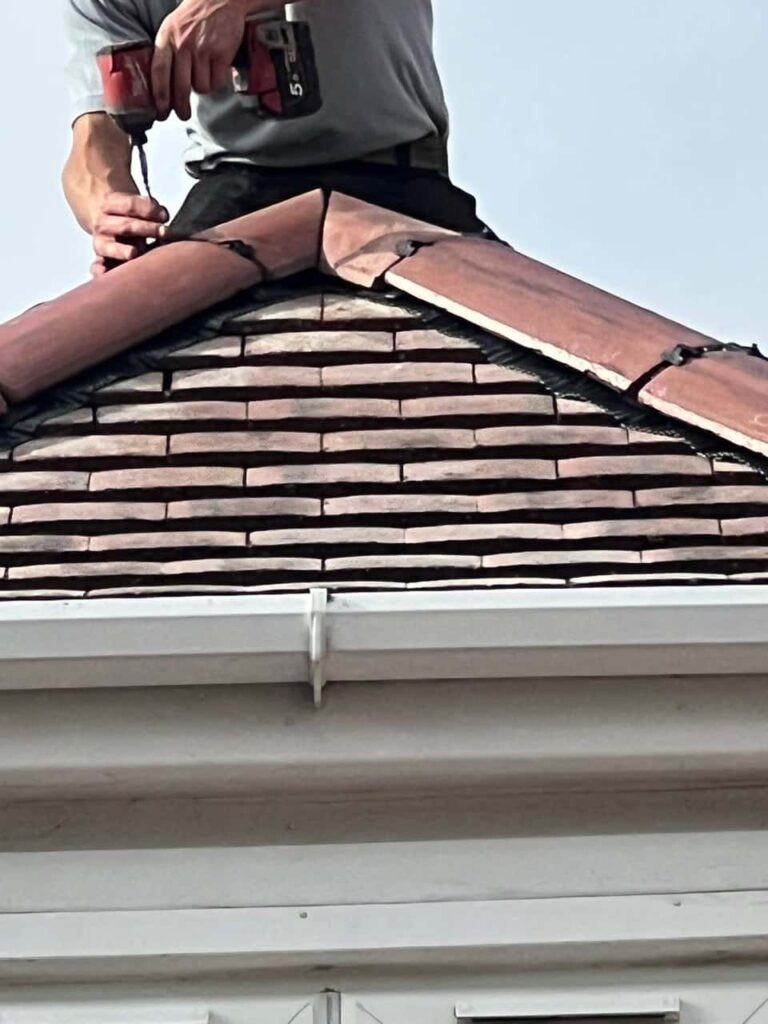Many homeowners first notice a roof problem when they see a discoloured patch spreading across the ceiling. It might start as a faint mark or small damp spot, but what lies above it is often far more serious than a simple leak. At Hurstpierpoint Roofing Repairs, we’ve inspected countless homes in Hurstpierpoint and across West Sussex where a seemingly minor ceiling stain revealed significant underlying roof damage. Understanding why damp ceilings occur and what they really indicate is key to preventing structural deterioration and maintaining your home’s safety.
The Hidden Dangers Behind a Damp Ceiling
A damp ceiling doesn’t just appear overnight. It’s a symptom of ongoing water penetration — a sign that moisture has already made its way through the roofing materials, underlayment, and insulation. By the time the ceiling shows visible signs, the issue may have already spread much further.
1. Long-Term Water Ingress
Water rarely enters through a single point and stops. It travels along beams, rafters, and joists, spreading moisture throughout the roof cavity. This can weaken wooden structures, promote mould growth, and lead to interior damage far beyond the visible stain.
2. Compromised Roof Layers
Modern roofs are built in layers — including tiles, felt, battens, and insulation — all designed to keep your property dry. When even one of these layers is breached, moisture seeps deeper, often resulting in unseen damage that continues to worsen over time.
3. Electrical Hazards
Moisture from a roof leak can reach light fittings, wiring, and ceiling fixtures, posing potential electrical risks. It’s one reason why damp ceilings should never be ignored, even if the water damage looks minor on the surface.
Common Causes of Damp Ceilings
While it’s easy to assume that a damp ceiling is caused by a single roof leak, there are often multiple contributing factors. At Hurstpierpoint Roofing Repairs, we typically find that the following issues are the root causes:
1. Damaged or Slipped Roof Tiles
Cracked or displaced roof tiles allow water to enter during rainstorms. Over time, even a single damaged tile can lead to a slow but persistent leak that eventually appears as a damp patch indoors.
2. Failing Flashing Around Roof Joints
Flashing protects the junctions around chimneys, skylights, and valleys. When it deteriorates or separates from the roof surface, it becomes a common entry point for water.
3. Blocked Gutters and Valleys
When gutters overflow or valleys fill with debris, water is forced back under roof tiles. This can cause leaks near walls or ceilings adjacent to the affected section of the roof.
4. Condensation in the Loft
Sometimes what appears to be a roof leak is actually condensation forming inside the roof space. Poor ventilation traps warm, moist air from the home, which condenses on cold surfaces and eventually drips down onto the ceiling.
5. Worn Underlayment
Beneath your tiles lies an underlayment membrane that provides an essential waterproof barrier. As it ages, it can tear or become brittle, allowing moisture to pass through even if the tiles above appear intact.
Why You Shouldn’t Ignore Damp Patches
A small damp patch might not seem urgent, but ignoring it can lead to far greater problems over time.
- Structural decay: Continuous moisture exposure weakens roof timbers and ceiling joists.
- Mould and mildew: Damp conditions create the perfect environment for mould growth, which can affect air quality inside your home.
- Increased repair costs: The longer moisture is allowed to spread, the more extensive (and expensive) the repair work becomes.
- Aesthetic damage: Paint, plaster, and wallpaper can peel, bubble, or stain, spoiling the interior of your home.
How Professional Roof Inspections Help
The only way to truly understand the cause of a damp ceiling is through a detailed roof inspection. At Hurstpierpoint Roofing Repairs, our experienced team conducts thorough assessments to identify exactly where and how water is getting in.
What We Check During an Inspection:
- Tile condition and alignment
- Flashing, ridges, and mortar integrity
- Underlayment and felt condition
- Gutter and valley blockages
- Loft ventilation and insulation performance
This full evaluation ensures that we don’t just patch over the symptom — we find and fix the source of the problem to prevent it from recurring.
Preventing Damp Ceilings in the Future
Prevention is always better than cure when it comes to roof maintenance. Homeowners in Hurstpierpoint can take several proactive steps to reduce the risk of leaks and damp:
- Schedule regular roof inspections: Catching small issues early prevents major damage later.
- Keep gutters clear: Regular cleaning ensures water drains away efficiently.
- Trim overhanging trees: Prevent debris build-up and physical roof damage during storms.
- Maintain good ventilation: Proper airflow in the loft helps reduce condensation build-up.
- Replace ageing materials: Older roofs benefit from periodic upgrades to maintain weather resistance.
Conclusion
A damp ceiling is never just a minor inconvenience — it’s often a warning sign that your roof has been compromised. By acting quickly, you can prevent serious structural damage, protect your home’s interior, and extend the lifespan of your roof.
Hurstpierpoint Roofing Repairs offers professional inspections, maintenance, and repair services across Hurstpierpoint and West Sussex. Our skilled team ensures every roof is restored to full strength, keeping homes dry, secure, and protected all year round.
Call us on: 01273 071 192
Click here to find out more about Hurstpierpoint Roofing Repairs
Click here to complete our contact form and see how we can help with your roofing needs.

